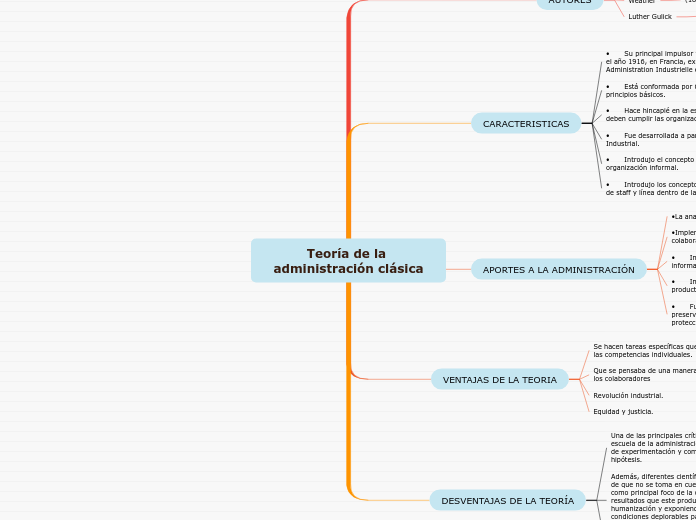Teoría de la administración clásica
To name your story, you have to think about the overall message and what you want your audience to understand from the story. Also, make it relevant and easy to remember.
DESVENTAJAS DE LA TEORÍA
Por último, los autores modernos denominan a la teoría clásica como «la teoría de la máquina», ya que está basada en acciones repetitivas de las cuales se esperan efectos correlativos
Además, diferentes científicos han criticado el hecho de que no se toma en cuenta el elemento humano como principal foco de la organización, sino los resultados que este produce, dejando de lado la humanización y exponiendo a los empleados a condiciones deplorables para maximizar su rendimiento.
Una de las principales críticas que se le hace a esta escuela de la administración, consiste en que carece de experimentación y comprobación de sus ideas e hipótesis.
VENTAJAS DE LA TEORIA
The ending of a story is essential. We all know that if the ending is weak, what happened before loses its importance. So make it unpredictable, but fair. A resolved ending answers all the questions and ties up any loose threads from the plot.
Equidad y justicia.
Revolución industrial.
Que se pensaba de una manera más incluyente a los colaboradores
This is the closure section of the story.
See examples of possible outcomes below:
- all problems have been solved
- it's clear how each one of your characters ends up
- your main character is transformed by the challenge
Se hacen tareas específicas que permiten desarrollar las competencias individuales.
This is the moment when the main character surpasses the last obstacle and finally faces their greatest challenge.
The climax usually follows one of these patterns:
- realization
- resolution
- choice
Type in your answer.
APORTES A LA ADMINISTRACIÓN
The middle of the story is where you add layers of complications that will lead to the end. Reveal more about the character's journey. Did their personality go through changes? How did they overcome the challenges? And as you build up the story’s central conflict, make it more personal to that character. Also, from the middle act, you have to lead into the final act.
• Funciones de seguridad: relacionadas con la preservación de los bienes de la organización y la protección de los integrantes de la misma.
• Introdujo venta, compra e intercambio de productos de la organización.
• Introdujo modelo d organización formal he informal
There wouldn't be any tension and excitement in your story if there weren't any obstacles in your character's way.
•Implementación dela importancia del espíritu de los colaboradores.
Your character(s) need(s) motivation in order to solve the challenge(s).
•La anatomía a la administración.
Each story has a main character and that character usually needs to solve a problem or challenge. The character's challenge is the one that creates tension throughout the story.
CARACTERISTICAS
• Introdujo los conceptos de órganos de asesoría de staff y línea dentro de la organización.
• Introdujo el concepto de organización formal y organización informal.
• Fue desarrollada a partir de la Revolución Industrial.
• Hace hincapié en la estructura y funciones que deben cumplir las organizaciones.
• Está conformada por 6 funciones y 14 principios básicos.
• Su principal impulsor fue Henry Fayol, quien en el año 1916, en Francia, expuso su teoría en el libro Administration Industrielle et générale.
AUTORES
In the beginning of the story (or the exposition), you will need to introduce the setting and characters. You might also want to introduce the main conflict. This part of the story is important because it gives the reader necessary background information and maybe even a first insight into a character’s personality.
Luther Gulick
(1884 – 1966).
Weather
(1891 – 1983).
•Henry Fayol
Characters are essential to a good story. Usually, the protagonist(s) is/are the most affected by the plot. Introduce a character by focusing on their actions, interests, and occupation, as the physical appearance doesn't make a difference in most cases.
(1841 – 1925).
Type in the name of your character.










